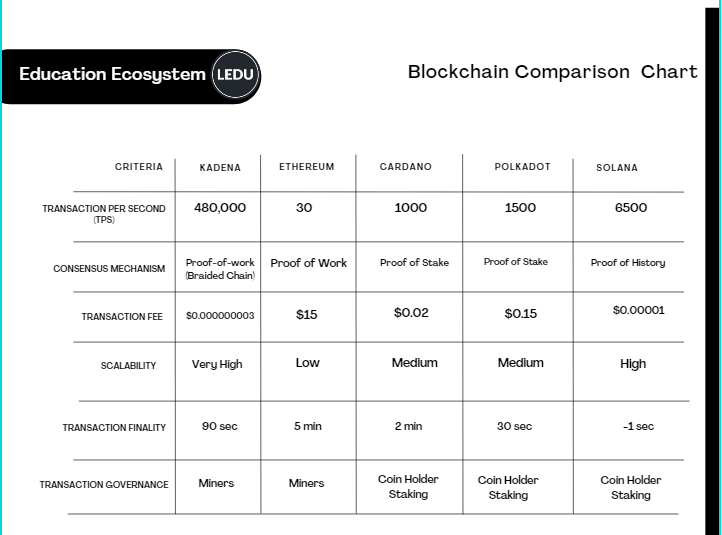
Introduction
Since the inception of Bitcoin in 2008, we’ve seen a rapid rise of a host of other blockchains, each with an innovative mode of operation, claiming to be The One, the best blockchain. These new blockchains have attempted to solve the major problem plaguing Bitcoin and the DeFi space—scalability.
Unlike Bitcoin which makes use of an energy-intensive and costly proof-of-work mechanism, these other blockchains are powered with innovations like smart-contracts, and novel consensus mechanisms like the proof-of-stake consensus mechanism and proof-of-history, giving them greater efficiency.
In this article we would attempt a fair comparison of a few of these new blockchains, namely, Kadena, Ethereum, Cardano, Polkadot and Solana. Providing a comparison chart along with an assessment of each blockchain based on consensus mechanism, transaction speed, scalability, and overall benefit. To begin, a brief overview highlighting key features of each blockchain is deemed necessary.
Kadena—Kadena consists of both a private blockchain (‘Kuro’ preventing public access to transactions) and a public one. Its public blockchain is an open-source smart contract called ‘Pact’ which allows anyone to design their own smart-contract. Pact is also equipped with a validation tool to verify codes in a smart contract. Kadena was built with the main purpose of enabling easy implementation of its technology in the real world. Kadena possesses its own native token which it uses for governance on its platform. Kadena boasts of an extremely high scalable platform capable of processing 480,000 transactions per second, surpassing even Solana. It is able to achieve such remarkable scalability with its novel blockchain design which it calls ‘Braided Chain.’
Ethereum—The popular Ethereum was built on the idea of Bitcoin but with a little addition, Smart contracts. It employs the proof-of-work mechanism using its Ethereum Virtual Machine, this enhances its function beyond simple ledger distribution. As the first blockchain to employ the use of smart contracts, Ethereum enables developers to create decentralized applications. Just like Bitcoin, operating the proof-of-work mechanism has led to a high reliance on computing power, making gas fees high. Hence the much-need for Ethereum 2.0 which adopts the staking consensus mechanism.
Cardano— Launched in 2017 by Charles Hoskinson, the co-founder of Ethereum, Cardano was built with the main purpose of becoming the “Internet of Blockchains” by establishing an ecosystem that enables easy interoperability between different blockchains. The Cardano blockchain also possesses a native token, Ada, named after Ada Lovelace, the 19th century mathematician. The blockchain employs the proof-of-stake consensus mechanism to validate new blocks. Achieving 1500 transactions per seconds.
Polkadot—Polkadot is an open-source blockchain with a unique feature that has earned it the ‘multi-chain network’. As an infrastructure blockchain, Polkadot allows for easy interoperability between independent chains like Bitcoin and Ethereum without the need for a trusted third-party. Polkapad’s native token, DOT, is used for governance on the platform. With a nominated proof-of-stake mechanism and its novel Parachains, Polkadot is able to achieve high scalability, processing 1500 transactions per seconds. The Polkadot blockchain employs an auction method as a means for hosting new projects on its blockchain, this helps select only projects with great potential. Ensuring steady growth of the platform.
Solana—After Kadena’s claims of 480,000 TPS, Solana appears to be the second fastest blockchain on the block. As a popular alternative to Ethereum, Solana is fast becoming the choice blockchain for developers and investors. Employing an innovative proof-of-history validation model, Solana is able to achieve a TPS of 65,000. Also, its native token SOL has experienced tremendous growth in the past year citing a greater future for Solana. Solana currently has over 350 applications currently operating on its blockchain with more to come.

Consensus Mechanism: A consensus mechanism also known as consensus protocols or consensus algorithms is simply the means by which blockchain transactions are validated and authenticated. This is necessary to ensure the legitimacy of transactions with a full record of these transactions. To achieve specific goals various blockchains operate different consensus mechanisms, the most popular of which are the proof-of-work and proof-of-stake consensus mechanisms, employed by Ethereum and Cardano respectively. On the other hand, Solana uses a proof-of-history mechanism to stand out from the pack.
Transaction Speed: Transaction speed signals an efficient blockchain. For more context, Ethereum is currently experiencing congestion, and transactions sometimes take up to 5 minutes to be confirmed, depending on fees. Unlike Solana which takes less than a second to validate a transaction. Due to the unreliability of TPS as a parameter because transactions per second can vary depending on how long it takes for the transaction to be validated it is better to base transaction speed on transaction finality.
Scalability: Mentioned a few times in this article, the reader must wonder what scalability really is. Scalability refers to the ability of a network to process a large number of transactions without causing congestion or delays to the network. Currently Kadena and Solana are proving to be the most scalable blockchains handling 480,000 and 65,000 transactions respectively with little to no delays and low fees.
Overall Benefit: Blockchains have ushered in a host of innovative technologies along with high security and transparency to its users. With the use of different validation mechanisms, benefits vary to both users and developers. Kadena aims to use its highly scalable network to provide real world solutions, Solana’s blockchain is proving to be the most efficient for both developers and users looking to invest long-term. Polkadot’s community-as-a-service would help developers hosted by Polkadot focus only on the technical aspect of their project, and Ethereum’s novel smart-contract has brought both pleasure and pain to the now congested network and its users; each offering unique benefits.
Conclusion
Your choice of blockchain could vary depending on what you’re seeking in the DeFi space, you could simply be looking for the best project token for holding or you could be a developer looking for the most suitable platform to build your project on. Each of the blockchains have been specifically designed to meet your blockchain needs.







